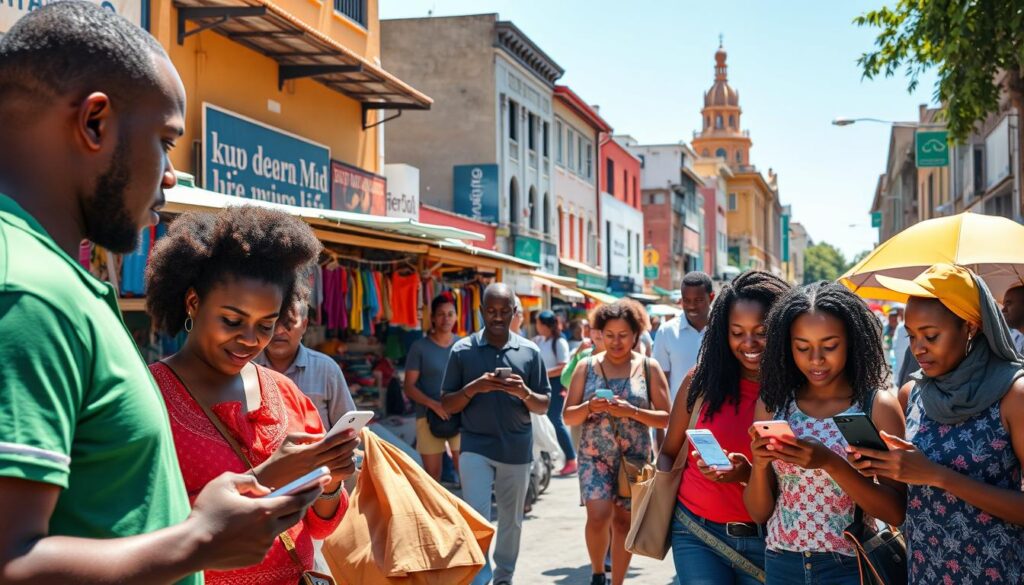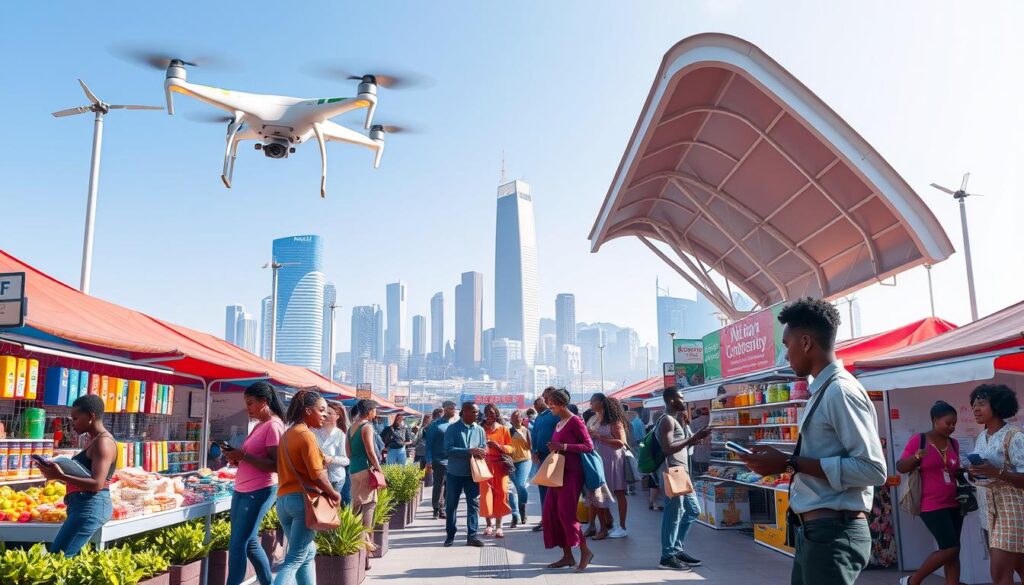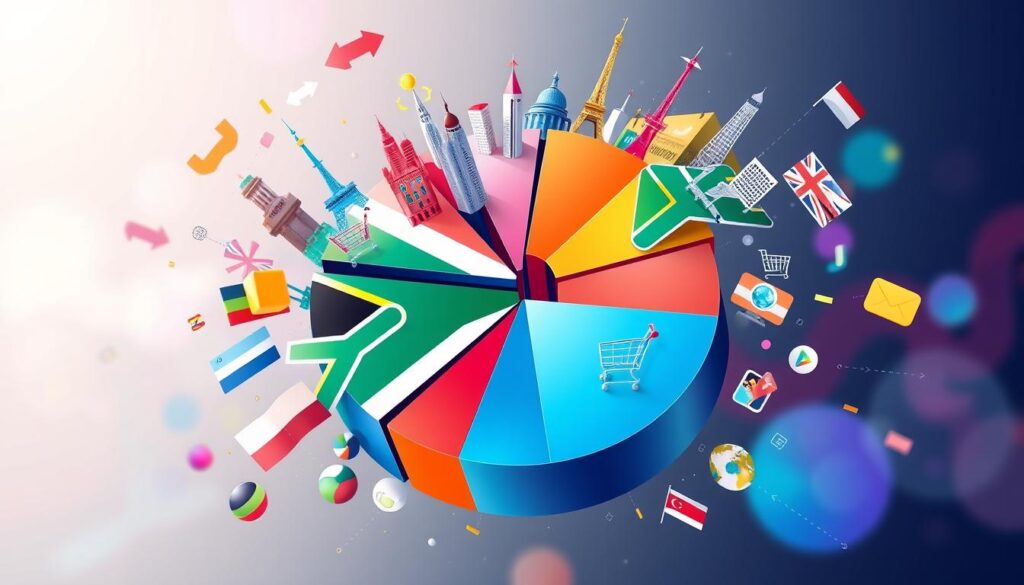I love shopping online and have seen how much South Africa’s e-commerce has grown. What started small has become a big digital world. It’s all about being resilient, innovative, and wanting easy shopping.
Numbers show how fast e-commerce is growing. By 2025, it’s expected to hit R225bn, up 150%. The pandemic made people shop online more, with 68% buying less in stores and 37% shopping online more.
This change is here to stay. It’s how people shop now. FNB saw a 30% jump in online spending in the first half of 2020. This shows how online shopping is becoming more popular.
Looking to 2025, South Africa’s e-commerce will grow a lot. More people, more cities, and a tech-smart youth will help. With 518 million users by 2025, businesses have a huge chance to grow.
Key Takeaways
- E-commerce transactions in South Africa are expected to surge 150% to R225bn by 2025.
- 68% of South African consumers reduced their frequency of visiting physical supermarkets due to the impact of COVID-19, while 37% increased their online shopping activity.
- FNB recorded a 30% year-on-year growth in average e-commerce spend during the 1st half of 2020 compared to 2019.
- The number of e-commerce users is expected to reach 518 million by 2025, with Nigeria, Kenya, South Africa, and Egypt identified as the main growth drivers.
- The South African e-commerce market is poised to experience unprecedented growth, driven by a growing population, increased urbanization, and a tech-savvy younger generation.
Current State of South African E-commerce Market
The e-commerce scene in South Africa is booming. It’s fueled by the quick adoption of mobile commerce, social commerce, and omnichannel retail solutions. The market is expected to see a huge jump, with e-commerce transactions valued at R225 billion by 2025.
Market Size and Growth Projections
The South Africa E-Commerce market is set to hit US$16.3 billion by 2030. It will grow at a rate of over 14.8% each year. In 2023, it was valued at US$6.2 billion, with a growth rate of 14.8%. The fashion industry is leading, thanks to high demand for clothes and accessories.
Key Market Players and Competition
The South African e-commerce market is competitive. It has both local startups and big international players. Names like Jumia, Konga, Amazon, BigCommerce, Shopify, Magento, WooCommerce, Squarespace, and Mall of Africa are prominent. The arrival of giants like Amazon will boost online shopping and increase competition, benefiting consumers.
Consumer Behavior Statistics
- 56% of South African consumers make multiple e-commerce purchases each month.
- 69.9% of respondents in South Africa make e-commerce purchases in clothing and fashion, making it the lead sector.
- 63.8% of respondents purchase food and drink products through e-commerce platforms.
- 69.9% of South African online shoppers make purchases from bed, 60% while at work or working from home, and 58.4% while watching television.
- Only 29.6% of respondents find value in AI chatbots for handling queries, while 71% appreciate AI for finding the best prices and 51.5% for tracking deliveries.
- 95% of South African online shoppers prioritize secure payment processing as the most crucial feature.
- Delivery costs are a significant hurdle for nearly 60% of respondents in South Africa when making online purchases.
- 90.1% of respondents in South Africa consider low star ratings or negative reviews a deterrent for making a purchase.
These insights show how consumer behavior and preferences are changing in South Africa’s e-commerce market. They offer valuable advice for businesses to adapt their strategies and offerings to meet the growing demands of this dynamic landscape.
Mobile Commerce Revolution in South Africa
The mobile commerce scene in South Africa is changing fast. Smartphones are becoming more common, and digital platforms are growing. With over 20 million smartphone users by 2023, mobile shopping is booming, up by over 50% in two years.
South African businesses are focusing on mobile first. This has led to more customers and sales. Big names like Takealot and Zando have made their sites mobile-friendly, meeting the changing needs of shoppers.
Social media like Instagram, Facebook, and WhatsApp are helping mobile commerce grow. The buy now, pay later (BNPL) option is also changing how people pay for things.
Mobile wallets like SnapScan, Zapper, and FNB’s eWallet are becoming popular. Hyperlocal delivery and video commerce are making mobile shopping better.
New tech like artificial intelligence (AI) and augmented reality (AR) is changing mobile commerce. AI chatbots and AR are making shopping more fun and personal.
But, there are challenges too. Keeping customer data safe is a big issue. Phishing and data breaches are threats. Also, not everyone has good internet, which can slow down mobile commerce growth.
Despite these hurdles, South Africa’s mobile commerce is thriving. It shows how the country is embracing digital change. As tech advances and security improves, mobile shopping will keep growing.
| Metric | Value |
|---|---|
| Smartphone users in South Africa (2023) | Over 20 million |
| Mobile commerce transaction growth (past 2 years) | Over 50% |
| Mobile payment services (examples) | SnapScan, Zapper, FNB eWallet |
| Mobile internet usage | Frequent, short browsing sessions |
| Ownership of mobile phones (South African adults) | Over 90% |

“The mobile commerce revolution in South Africa is a testament to the country’s digital transformation, with businesses and consumers embracing the convenience and innovation of mobile-driven commerce.”
Digital Payment Transformation and Embedded Finance
South Africa’s e-commerce is changing fast, thanks to new Cashless Payment Solutions and Digital Wallets. Embedded Finance is key in this change. It combines financial services with other platforms, shaping digital transactions.
Cashless Payment Solutions
The embedded finance market in South Africa is growing fast. It’s expected to reach US$717.7 million by 2024. By 2029, it could hit US$1.82 billion, growing 20.5% each year.
Financial institutions, fintech, and other sectors are working together. They aim to offer smooth Cashless Payment Solutions to everyone.
Digital Wallet Adoption
Digital Wallets are becoming more popular in South Africa. Fintech companies are introducing Buy Now, Pay Later (BNPL) options. These are integrated into e-commerce sites, giving consumers flexible payment choices.
Payment service providers are also improving embedded payment solutions. They’re making transactions smoother in retail and hospitality apps.
Financial Technology Integration
South Africa is updating its rules to support fintech innovations. This includes digital payments and lending. The goal is to include more people in the financial system through Embedded Finance.
Rules like the Protection of Personal Information Act (POPIA) are being strengthened. They aim to protect consumer data as Embedded Finance grows.

“The embedded finance industry in South Africa is projected to grow annually by 7.3% to reach US$717.7 million in 2024, with a forecasted compound annual growth rate (CAGR) of 20.5% from 2024 to 2029, potentially reaching US$1.82 billion by 2029.”
As South Africa’s e-commerce grows, integrating Cashless Payments, Digital Wallets, and Financial Technology will be vital. They will drive the Digital Transformation and shape the future of digital commerce.
E-commerce Trends in South Africa: Market Analysis
The e-commerce landscape in South Africa is changing fast. Many industries are showing strong growth potential. The tourism, entertainment, variety goods, and professional services sectors lead in e-commerce.
The groceries sector is catching up, with a 54% rise in online sales in 2020. The apparel industry is also expected to grow, thanks to online shopping’s convenience.
Smartphone use is a big trend in e-commerce trends in South Africa. It lets more people shop online easily. Discounts, promotions, and easy shopping experiences are key to keeping customers.
| Sector | E-commerce Penetration | Growth Potential |
|---|---|---|
| Tourism and Entertainment | High | Moderate |
| Variety Goods | High | Moderate |
| Professional Services | High | Moderate |
| Groceries | Low, but Improving | High |
| Apparel | Moderate | High |
The South African e-commerce market is diverse. Many big players are innovating to stay ahead. Decathlon, Takealot Online (Pty) Ltd., Superbalist.com, Sofresh, and Care to Beauty are leading the way.

“The COVID-19 pandemic acted as a catalyst for e-commerce growth in South Africa, prompting a surge in online shopping due to lockdowns and safety concerns.”
As e-commerce trends in South Africa keep changing, businesses need to keep up. They must meet new consumer needs, use new tech, and stay on top of market shifts to succeed.
Impact of International Players on Local Market
Global e-commerce giants like Amazon have entered the South African market. This has made digital shopping more popular and competitive. Now, consumers can find more products at better prices. But, local retailers face challenges to keep up with these changes.
Amazon’s Entry Effects
Amazon started in South Africa in 2024. It brought a huge selection of products, fast delivery, and low prices. This has drawn many South African shoppers. Local stores must now improve their online presence and customer service to compete.
Competition Dynamics
The merger of Wasoko from Kenya with MaxAB from Egypt has created a big B2B e-commerce platform. It aims to lower costs and make essential goods more accessible. Egyptian companies like Halan and Talabat are also growing, offering more services. This competition is driving innovation and pushing the market forward.
Market Share Distribution
| E-commerce Player | Market Share |
|---|---|
| Takealot | 35% |
| Amazon | 20% |
| Wasoko-MaxAB | 15% |
| Halan | 10% |
| Talabat | 8% |
| Others | 12% |
The table shows Amazon’s big impact and the rise of Wasoko-MaxAB, Halan, and Talabat. Takealot still leads, but the market is changing. Retailers must keep up with Digital Transformation and Omnichannel Retail to stay competitive.

Supply Chain and Logistics Evolution
The e-commerce boom in South Africa is changing the supply chain and logistics scene. More businesses are going online, making fast and affordable delivery key to success. About 5,000 South African businesses now have an online presence and earn over R100,000.
To meet consumer demands for quick, reliable, and green delivery, logistics are getting a digital makeover. They’re using Supply Chain Optimization and Digital Transformation to innovate. This includes better last-mile delivery, smarter warehouse management, and the use of new tech like automation and robotics.
Embracing Sustainable Logistics Practices
Logistics companies in South Africa are focusing on sustainability. They’re doing this to cut down on carbon emissions and meet consumer and environmental demands. They’re using electric vehicles, renewable energy, and optimizing routes to reduce emissions.
These efforts not only help the planet but also make logistics companies more competitive.
Leveraging Technology for Efficiency and Resilience
The African e-commerce market is set to grow, with over 500 million users by 2025. To keep up, logistics are turning to tech like automation and data analytics. These tools boost efficiency, cut costs, and improve supply chain management, making for a better customer experience.
| Key Logistics Trends in South Africa | Impact |
|---|---|
| Sustainable logistics practices | Reduced carbon footprint, enhanced competitiveness |
| Automation and robotics integration | Improved efficiency, cost-effectiveness, and precision |
| Last-mile delivery innovations | Overcoming infrastructure challenges, meeting evolving consumer demands |
As e-commerce grows in South Africa, the logistics sector must evolve. By adopting Supply Chain Optimization and Digital Transformation, they can offer efficient, green, and customer-focused services. This meets the market’s changing needs.

Consumer Shopping Behavior and Demographics
The South African e-commerce scene has changed a lot, thanks to the COVID-19 pandemic. It has made online shopping behavior grow faster. A Nielsen study found that 68% of people in South Africa visited supermarkets less often. At the same time, 37% shopped online more.
Young people in Africa are leading the way in e-commerce growth. They are more likely to shop online. The study found 12 things that affect online shopping behavior. The top ones are usefulness, trust, convenience, and how easy it is to use.
Urban vs Rural E-commerce Adoption
E-commerce growth in South Africa is not the same everywhere. Urban areas are seeing more online shopping, but some rural areas are not happy with their online shopping experiences.
Age Group Shopping Patterns
Online shoppers in South Africa come from all ages. But, 25% of them are over 60 years old. Still, the younger crowd makes up most of the online shoppers, with over 55% being male.
Customer Experience Expectations
The pandemic has changed what customers expect. Now, they think every business should accept digital payments. South African shoppers value loyalty but are willing to switch for better deals. This shows how important personalization and promotions are in e-commerce.
“The growth rate of South African ecommerce sales ranges between 20-35% annually, indicating the vast potential for further expansion in the sector.”
| Demographic | Online Shopping Behavior |
|---|---|
| Urban Consumers | Increased adoption of e-commerce |
| Rural Consumers | Some dissatisfaction with online shopping experiences |
| Younger Consumers | More likely to adopt online shopping practices |
| Older Consumers (Over 60) | 25% of South Africa’s online shoppers |
| Male Consumers | Over 55% of local online shoppers |
Technology Infrastructure and Digital Adoption
South Africa’s e-commerce scene is changing fast, thanks to more people going digital. But, the growth is slowed down by tech issues and high data costs. Businesses are focusing on cybersecurity to keep online deals safe and gain trust from customers. This makes better digital infrastructure even more important.
The story of South Africa’s digital journey starts with early recognition of digital’s power. Naspers, a big tech player, started Kalahari.net in 1998 as an e-bookstore. This move, like Amazon’s, helped kickstart e-commerce in South Africa.
But, there are still big hurdles in Digital Transformation and Cybersecurity. Not having enough data on digital trends makes it hard to see where South Africa stands globally. Problems like data privacy, job loss, skill gaps, and poor infrastructure also slow down digital growth.
The report says we need everyone to work together to move forward. This includes the government, private companies, research groups, and civil society. Working together is key to growing, making digital industries stronger, and sharing the benefits of digital change fairly.
“The report highlighted South Africa’s digital transformation journey coinciding with the 30 years of democracy in the country.”
As South Africa dives into the digital age, the private sector is leading the way. They’re investing in new tech and digital platforms. Banks, finance, and telecoms are leading this change, pushing for cloud software and better internet security.
The future for South Africa’s digital world looks bright, but it needs hard work to overcome tech and rule challenges. By working together and focusing on digital skills, the country can reach its full e-commerce and digital potential.
Retail Sector Digital Transformation
South African businesses need to adapt to the digital world. They must turn their in-store services into online options. This means offering customers choices like starting a purchase online and finishing it in-store or upon delivery.
Using customer data is key for personalization. It helps improve the shopping experience. This is crucial for success in the digital age.
Retailers are now focusing on mobile shopping. They create easy-to-use apps and offer special deals for app users. This meets the growing demand for mobile shopping in South Africa.
Digital transformation also means using advanced tech like AI. This helps personalize shopping and keep customers loyal.
The online retail market in South Africa is booming. Retailers must create e-commerce sites that grow with their business. By using digital tools, they can understand customer habits, manage stock better, and boost sales with targeted offers.
This approach leads to a more personalized and enjoyable shopping experience. It’s essential for staying ahead in the competitive market.
